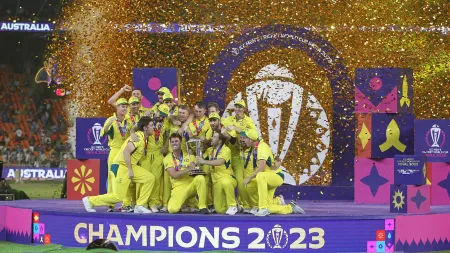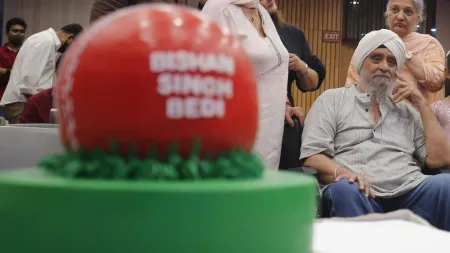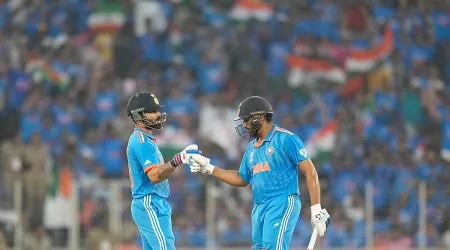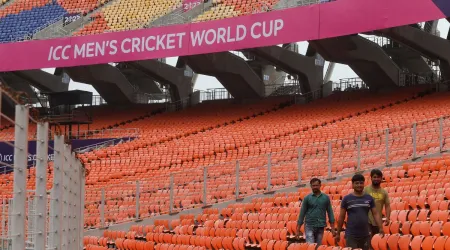- India
- International
Khali’s fight club: Pro-wrestling building a cult in India
Far from the tense faceoff on the country’s western front is the make-believe world of pro-wrestling. But here too is a familiar script: India squaring off with Pakistan. Also in the mix are a dubious baba, a corrupt police officer and a feisty woman. GAURAV BHATT on how pro-wrestling is slowly building a cult following in India, one punch at a time.
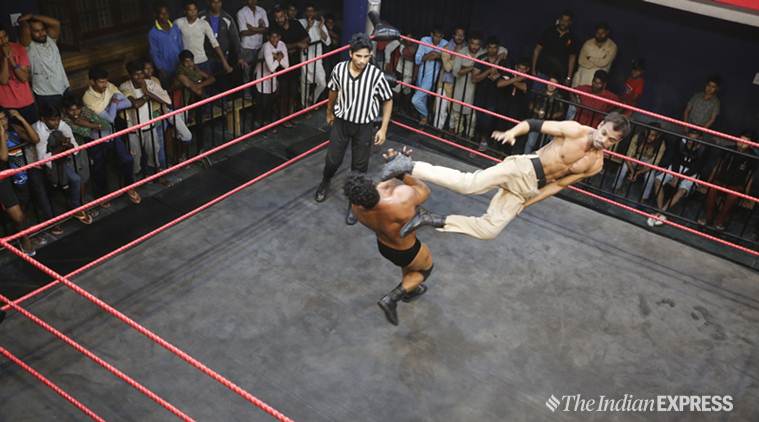 Like with WWE and its brand of American nationalism, Khali’s version rarely strays from the “us versus them” narrative. (Express Photo: Jasbir Malhi)
Like with WWE and its brand of American nationalism, Khali’s version rarely strays from the “us versus them” narrative. (Express Photo: Jasbir Malhi)
There’s a rare silence at The Great Khali’s wrestling academy at Kangniwal village in Punjab’s Jalandhar district. The wrestlers are mourning the death of the 40 CRPF personnel killed in the Pulwama terror attack on February 14. Seconds later, the stillness is smashed with a rant and some expletives directed at Pakistan. The show begins.
Set up by wrestler Dalip Singh Rana a.k.a. The Great Khali in January 2015, the academy is the base for Continental Wrestling Entertainment (CWE), the Indian version of World Wrestling Entertainment (WWE), the American pro-wrestling behemoth that’s known for its edgy entertainment and exaggerated characters.
What began as a training academy — with the CWE ring hosting the weekly Saturday night fights — has over the years evolved into a touring event, with pro-wrestling shows being held across Punjab, Haryana, Himachal Pradesh and Uttarakhand. But the growing popularity of CWE and pro-wrestling, with the format slowly acquiring a cult following in parts of the country, is in large measure due to its online avatar — the videos on social media platforms such as YouTube.
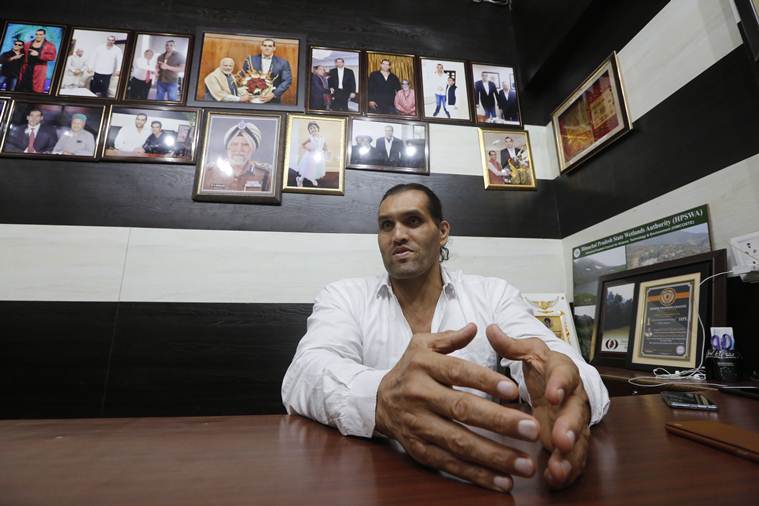 Set up by wrestler Dalip Singh Rana a.k.a. The Great Khali in January 2015, the academy is the base for Continental Wrestling Entertainment. (Express Photo: Jasbir Malhi)
Set up by wrestler Dalip Singh Rana a.k.a. The Great Khali in January 2015, the academy is the base for Continental Wrestling Entertainment. (Express Photo: Jasbir Malhi)
The group’s latest video, uploaded on February 22 and titled ‘CWE family shows anger on terrorism acts at Pulwama Jammu’, has a four-minute tirade by a wrestler in police uniform urging “revenge”. The video has been viewed 1.3 million times, with abusive comments from both sides of the border.
Like with WWE and its brand of American nationalism, Khali’s version rarely strays from the “us versus them” narrative, with plots revolving around the Indian ‘hero’ bashing and overpowering the Pakistani ‘villain’. This concept of strong protagonists defending a nation’s pride against evil foreigners in simulated contests, which are part-performance, part-sport, is as old as pro-wrestling itself.

But unlike in the US, where years of WWE have spawned an audience that is ready to debate problematic plots, in India, pro-wrestling, though hugely popular, remains largely a mock-sport shorn of any intellectual pretence, a pursuit whose viewers are not rushing online to debate political correctness.
The videos themselves are hardly subtle. But then, subtlety has never had a place in the world of professional wrestling. What matters are the eyeballs — and CWE is getting its share of those. CWE’s YouTube channel has over 1.5 million subscribers, with each video averaging close to a million views.
***
Spread across eight acres, the two-storey CWE academy trains 150 wrestlers, who are put up on the second floor of the building. There’s a gym and a mess, and in one corner on the ground floor is Khali’s office, the walls of which are covered with photographs of the WWE alumni posing with prominent personalities, including PM Narendra Modi and US President Donald Trump.
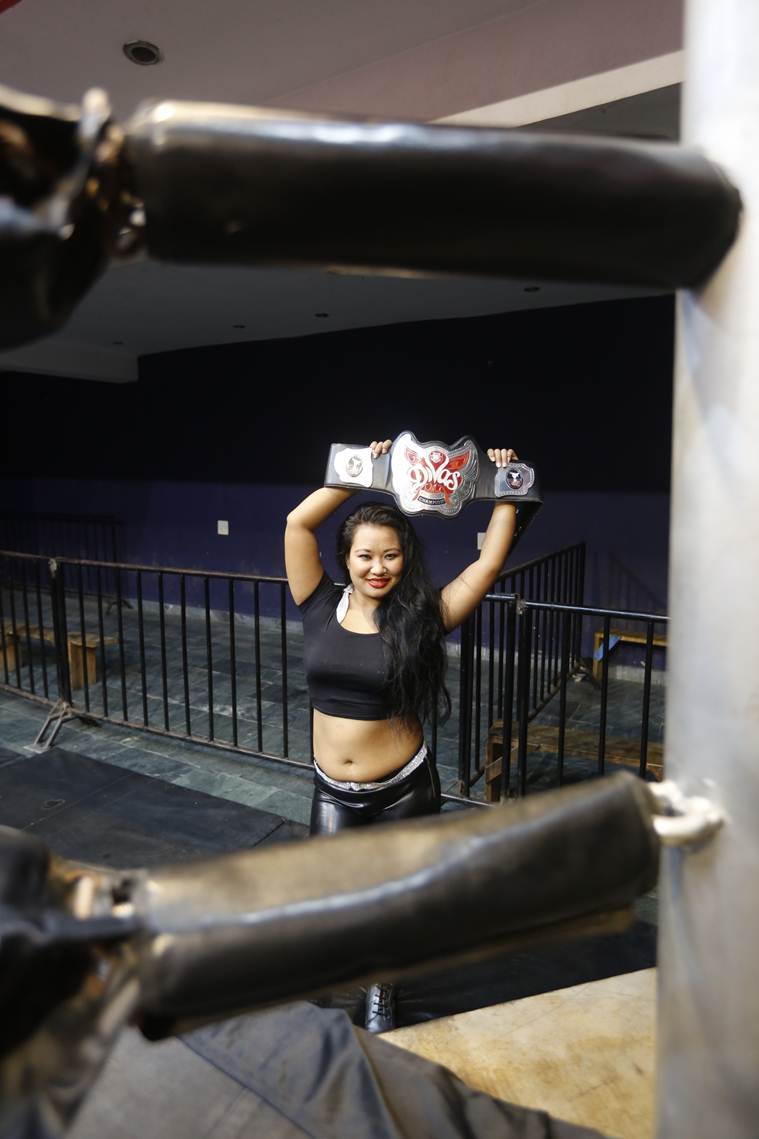 While the wrestlers — both the CWE graduates and the students — usually build on the characters themselves, the storyline, matches and results are decided by Khali. (Express Photo: Jasbir Malhi)
While the wrestlers — both the CWE graduates and the students — usually build on the characters themselves, the storyline, matches and results are decided by Khali. (Express Photo: Jasbir Malhi)
In the centre of the academy is the ring where the action unfolds every Saturday, when nearly a hundred all-male audience from Jalandhar and villages nearby gather to watch the fights.
The wrestlers at the academy are a bunch of 20-somethings — a mix of former athletes, mat wrestlers, bodybuilders and even an accountant — who pay up to Rs 30,000 a month for lodging, accommodation and training. They are trained by local coaches and visiting foreign instructors — mostly Khali’s old colleagues — who teach them how to perform maneuvers, build up cardio and fall flat on their backs without getting hurt.
While the wrestlers — both the CWE graduates and the students — usually build on the characters themselves, the storyline, matches and results are decided by Khali. As the promoter of the company, Khali is supreme; if he chooses to, he can even make a wrestler lose for an entire year.
The villain is almost always ‘Faruqua Khan’, who is, predictably, from Pakistan. Corrupt police officer ‘Dubeyji’ and ‘Baba Raghudev’ round off the rogues’ gallery. There is a woman character too, ‘Cheeni Aaliya’, and contending with them all is Gurvinder Singh Malhotra a.k.a. ‘Shanky Singh’, the 7’1” poster boy of CWE who is now on a brief hiatus and is shooting for a Salman Khan film.
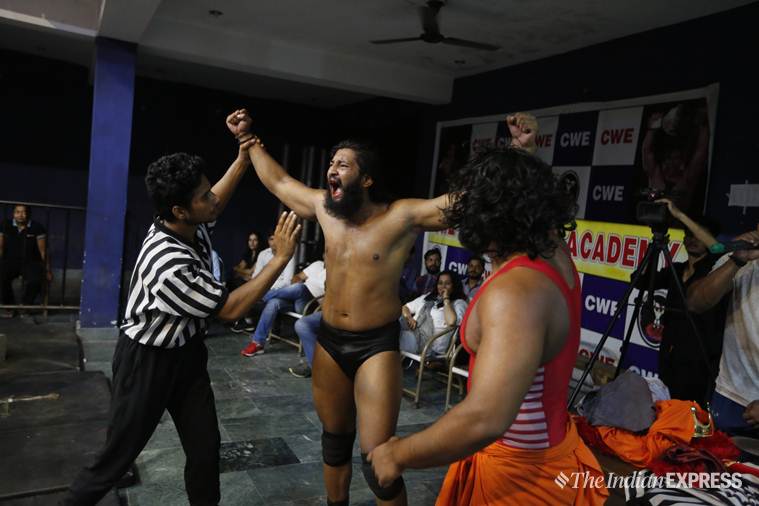 The wrestlers at the academy are a bunch of 20-somethings — a mix of former athletes, mat wrestlers, bodybuilders and even an accountant. (Express Photo: Jasbir Malhi)
The wrestlers at the academy are a bunch of 20-somethings — a mix of former athletes, mat wrestlers, bodybuilders and even an accountant. (Express Photo: Jasbir Malhi)
“Mera aur Faruqua Khan ka chattis ka aankda tha (Faruqua Khan and I are sworn enemies) — both in the ring and outside,” says Shanky Singh on the phone from his home in Jagadhri, Haryana, effortlessly slipping in and out of character. Pro-wrestling stars are known to go to great lengths to not reveal their real identities, fearing doing so might ruin their act.
Shanky also insists the fights are “not fake”. “Outside the ring, our lives are different but sometimes, in the heat of the moment, you can actually get hurt. Fir dushmani ho jaati hai (You become enemies in real life as well),” says the 28-year-old who became Shanky when he joined the CWE academy in 2015.
In the years that followed, and with the social media boom, Shanky became an online sensation as videos of his run-ins with Faruqua Khan and Tiger Khan, billed as ‘brothers from Pakistan’, lit up the Internet.
In these videos, shot in the academy or in fields, construction sites or stretches of National Highway 3 around the institute, Shanky’s ‘Pakistani’ opponents also dress the part. The Khan brothers arrive in the ring in kurtas and skullcaps, kneel to offer a quick prayer, and always keep a Pakistan flag handy. The brothers are usually simply called “Pakistan”, giving the ‘hero’ an opportunity to proclaim that he “defeated Pakistan”.
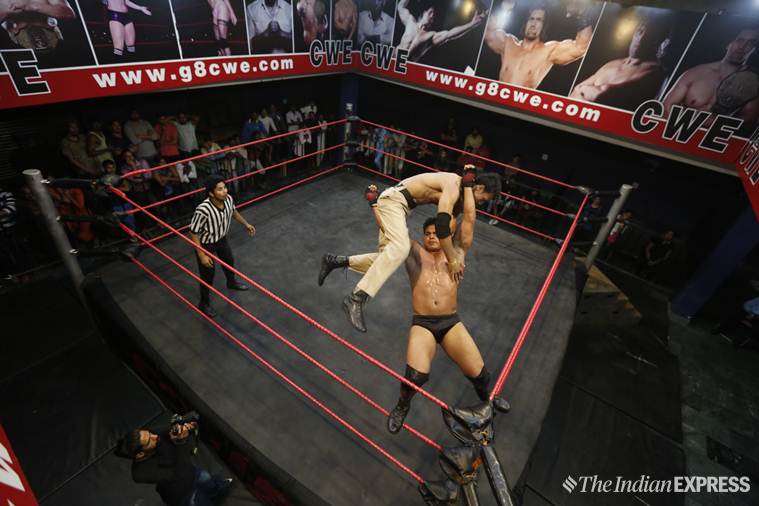 The wrestlers are trained by local coaches and visiting foreign instructors. (Express Photo: Jasbir Malhi)
The wrestlers are trained by local coaches and visiting foreign instructors. (Express Photo: Jasbir Malhi)
The clips, two-to-five minutes long, are amateurish, with no hint of political correctness. Like the one video titled ‘Shanky Singh forcing begum and doing whatever he wants’, where the protagonist is seen forcing Faruqua’s ‘begum jaan’ into a room. The woman yells for help, and ‘Mr Prajapati’ — a king wearing a robe over speedos and a crown — and his aide ‘Baba Raghudev’ rush in to help. The scene somehow shifts to the entire room dancing to Shanky’s aggressive rendition of Bolo tara ra ra.
The videos almost always end the same way: with Shanky lifting villain Faruqua by the neck and throwing him down, or ‘chokeslamming’ him — outside a sweet shop, in a potato field, on a concrete pathway. Shanky recalls how he was “sick” of his job as an accountant, and wanted to try something different. “I was tall, and people would say that I could take up wrestling. I thought let’s give it a shot,” he says.
“I was never an athlete, so I got hurt a lot in practice and during the fights. I also had a breathing problem. People said I would not be able to do it… Ab mera Wikipedia bhi bann gaya hai (Now I have a Wikipedia page),” he smiles.
Divya Aale didn’t have an easy start either. As a four-year-old, Divya got hooked to wrestling when she saw The Undertaker toss Mick Foley off a 16-foot-tall steel cage. Her family didn’t mind their daughter’s interest in the sport, at least not until Divya completed her schooling. That is when her father, a Northern Coalfields Limited employee in Singrauli, Madhya Pradesh, sat her down and said, “You can’t do this in India. It’s western culture and people will not accept you,” she recalls.
She says she took up contemporary dancing and, at 23, went to London as part of a troupe, where local wrestling shows rekindled her passion. Divya cut short her London stint and, two years ago, traded the dance floor for wrestling. “My parents realised that I was never going to give this up, so they gave up arguing with me,” she says.
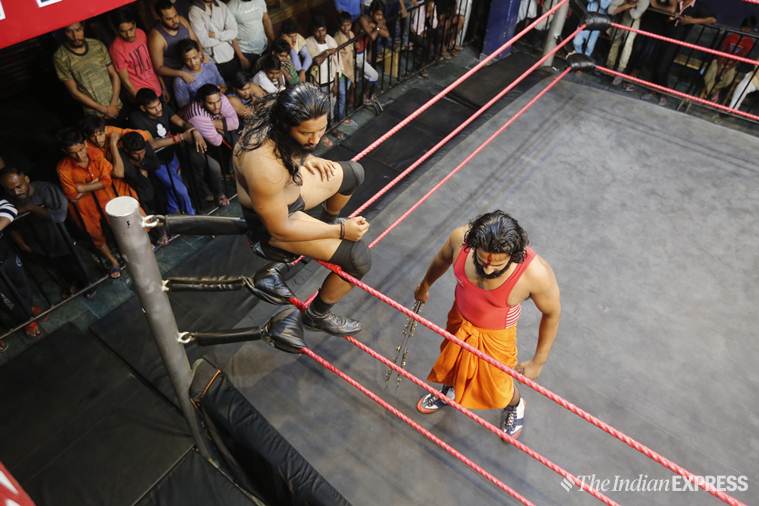 In India, pro-wrestling, though hugely popular, remains largely a mock-sport shorn of any intellectual pretence. (Express Photo: Jasbir Malhi)
In India, pro-wrestling, though hugely popular, remains largely a mock-sport shorn of any intellectual pretence. (Express Photo: Jasbir Malhi)
In Jalandhar, Divya, who goes by the ring name ‘Cheeni Aaliya’, is often the lone woman at the shows. “I end up wrestling with men most of the time. The dancing experience helps, but you do hurt yourself. You need to fall on the hard canvas, again and again,” says Divya. But it’s the YouTube comments — ridiculing her ring gear of crop-tops and shorts and lecturing her on modesty by pointing to CWE graduate and current WWE trainee Kavita Devi, who wrestles in a salwar-kameez — that bother her the most. That Divya is often portrayed as a vixen with provocative lines doesn’t help either.
“While commenting on my videos, people write unpleasant things, call me Nepalese, Chinese… My parents are from Nepal, but I was born and brought up in India. The comments hurt,” she says.
So did her screen name when Khali first suggested that to her. “Cheeni Aaliya,” she laughs. “I told Khali sir cheeni is an offensive term. He said, ‘Cheeni means sugar. You are the sweetest, that is why you have been given this name’.”
Raghubir Singh, a 25-year-old wrestler from Amritsar who usually plays godman ‘Baba Raghudev’, says it was “difficult for a wrestler to be a sadhu”. “I was very nervous in the beginning. Then I started growing my hair and wore a garland around my neck… Khali sir told me to learn to play the conch,” says Raghudev, who wrestles in a saffron dhoti.
Manish Dubey, or ‘Singham Dubey’ or simply ‘Dubeyji’, had it easier. Having worked as a police officer for a year, the 25-year-old from Andaman Islands only had to play a caricaturised version of himself. Dubey says no corrupt police officer or villain gets the audience as worked up as the Pakistani antagonists do. “It’s like, the audience thinks, ‘They’re corrupt people, but at least they are our corrupt people’,” explains Dubey.
In August last year, possibly fearing a backlash for keeping ‘Pakistanis’ on its rolls, CWE stopped using Faruqua and his partner Tiger Khan for their shows or in their videos. Until they re-emerged last month, in Palanpur, Gujarat.
***
Late last year, Ravi, who played ‘Mr Prajapati’ for CWE, decided to strike out on his own, forming the rival pro-wrestling company, Asian Wrestling Entertainment (AWE), with help from some local sponsors. The 22-year-old roped in fellow CWE fighters, including Shanky, and held the company’s first show on January 5 in his home state, Gujarat. The venue: a college ground in Palanpur, 145 km from Ahmedabad.
Much like the CWE shows, this too was promoted as an ‘India vs Pakistan’ fight, with Ravi and younger brother ‘Shani Prajapati’ squaring off against Faruqua Khan and his new partner.
But an hour before the show, the ‘Pakistanis’ were dropped. One of the sponsors, a local bigwig, took the mic and announced: “They wanted to bring Pakistanis here. I told them that if they go through with the match, I will withdraw my support.”
 Nearly a hundred all-male audience from Jalandhar and villages nearby gather to watch the fights. (Express Photo: Javed Raja)
Nearly a hundred all-male audience from Jalandhar and villages nearby gather to watch the fights. (Express Photo: Javed Raja)
The AWE event, a sharp contrast to the organised events of Khali’s CWE, unravelled quickly. There were no barricades near the ramp and the organisers struggled to keep the spectators in check. When the show began, the audience in the front rows kept moving ahead along with their chairs, which had been arranged haphazardly around the ground. Those at the back stacked theirs up and stood on them for a better view. Then, midway through the show, the organisers, to counter the lacklustre response to the event priced at over Rs 500 per head, opened the gates for people surrounding the venue.
Inside the ring too, things didn’t go as planned. The ropes around the ring were loose and slippery, and the fighters trying to go for aerial moves fell, injuring their necks and head. But the coup de grace was still to follow. By the time the hometown heroes, the Prajapati brothers, made an appearance, the audience had been waiting for over four hours and was restless. But instead of quickly running through their opponents (Shanky Singh played a villain here), the brothers decided to go in for some slow-burn drama. Someone in the audience flung a chair into the ring, sparking a near-stampede as spectators scrambled across the ropes to beat up the fleeing wrestlers. No police complaint was filed; a couple of policemen at the scene dismissed it as a scuffle.
 The ropes around the ring were loose and slippery, and the fighters trying to go for aerial moves fell, injuring their necks and head. (Express Photo: Jasbir Malhi)
The ropes around the ring were loose and slippery, and the fighters trying to go for aerial moves fell, injuring their necks and head. (Express Photo: Jasbir Malhi)
The organisers tried to soothe tempers with some display of fireworks. A bloodied Prajapati sprang up and yelled into the mic: “Main jeeta hun, bhaiyon! I have won!” Too little, too late. By then, many in the audience had run away with chairs, wallets and phones as souvenirs.
A day later, one of the organisers said, “There was too much excitement yesterday… It could have been more exciting had the Pakistanis been there.”
***
“This academy is the result of my 18 years of wrestling… I learnt a lot from (WWE chairman) Vince McMahon,” says Khali settling down after an exciting Saturday night show at the CWE academy in Kangniwal.
Among the things he learnt in his 18 years as a wrestler, 10 of those with the WWE, what is undisputed is Khali’s ability to grab eyeballs. The 46-year-old, who was introduced in the WWE in 2006 as The Undertaker’s nemesis, spent the last few weeks of his contract in 2014 as a tooth fairy, dressed in a strappy pink dress and wearing fake wings. What next then?
“People have approached me for a television deal, but I don’t want to rush in. It has to be my vision and design,” says Khali. “Others have tried and failed, but once we get our type of deal, this could be special.”
 “This academy is the result of my 18 years of wrestling… I learnt a lot from (WWE chairman) Vince McMahon,” says Khali. (Express Photo: Jasbir Malhi)
“This academy is the result of my 18 years of wrestling… I learnt a lot from (WWE chairman) Vince McMahon,” says Khali. (Express Photo: Jasbir Malhi)
However, the veteran wrestler admits, while a TV deal would help make CWE popular, it could also put a filter on the show’s raw content — unlike YouTube, where videos such as ‘Bihari mazdooron ne maara Shanky Singh ke bhai ko’ go uncensored.
Shot at the potato farm near the academy, the video depicts Shanky’s ‘brother’ getting pummelled by migrant workers (played by CWE trainees). Soon, Shanky, the hero, arrives, chokeslams one onto the rest, while repeatedly yelling expletives at “**** Bihariyon”. All this while, the real migrant workers in the potato farm look on bemused.
Many of them are among the loyal audience at the academy every Saturday. Much like the working class in the US in the 1980s, suspension of disbelief and a few targeted insults are a small price to pay for three hours of entertainment.
“We come here every time. Thoda drama zyaada hi karte hain ye (There is a lot of drama), but it’s free entertainment,” says a labourer as another Saturday show winds up at Khali’s academy.
Carnival sport to politics, pro-wrestling show goes on
Known to be brazenly political, pro-wrestling, now a billion-dollar industry, traces its origins to strongman competitions held during carnivals in the early 20th century. Often derided as pseudo-sport, pro-wrestling has thrived for more than a hundred years, and like folklore and mythology, its characters come in shades of black or white, and most problems are solved through violence.
 Khali’s version rarely strays from the “us versus them” narrative, with plots revolving around the Indian ‘hero’ bashing and overpowering the Pakistani ‘villain’. (Express Photo: Jasbir Malhi)
Khali’s version rarely strays from the “us versus them” narrative, with plots revolving around the Indian ‘hero’ bashing and overpowering the Pakistani ‘villain’. (Express Photo: Jasbir Malhi)
In the 1980s, the wrestlers took their shows to the industrial towns in the American South and West. There, ‘rich guys’ such as Richard Morgan Fliehr a.k.a. Ric Flair a.k.a. ‘The Nature Boy’ were villains while the likes of ‘American Dream’ Dusty Rhodes championed blue-collar workers dealing with the economic uncertainty of the Reagan era. But pro-wrestling’s most populist theme, one that struck a chord with the working class, was patriotism that often bordered on xenophobia. Snooty Englishmen, burly Soviet supermen or diabolical Middle Easterners have been cheating, scheming and receiving their comeuppance for almost all of the show’s existence.
The storylines often trod dangerous ground: a Texan millionaire kicking out illegal immigrants at the Mexican border; a team of black wrestlers called ‘Cryme Tyme’ stealing from their opponents; an Italian-American dressed as an Arab called Muhammad Hassan leading an attack on The Undertaker.
More recently, the stories have mirrored the current political climate in the US. In 2016, US President Donald Trump was inducted into the WWE Hall of Fame for sponsoring the early WrestleMania events, and participating in one in 2007, where he ‘brawled’ with CEO Vince McMahon. Soon after his election, Trump posted a clip from the match on Twitter, replacing McMahon’s face with the logo of news channel CNN.
A staunch Republican, McMahon donated millions to Trump’s presidential campaign, and his wife Linda is part of the President’s cabinet. Expectedly, McMahon’s and WWE’s notion of the ‘villain’ isn’t very different from the President’s.
For instance, the company’s biggest ‘bad guy’ is the 5’6” flannel and hipster-beard sporting, climate-conscious Daniel Bryan, who lectures the crowd for drinking from plastic bottles, eating factory-farmed meat, driving gas-guzzlers and talks about the planet dying due to consumption.
But not everyone sees Bryan, the current WWE champion, as the bad guy. In a recent show, Bryan had replaced the WWE title belt (a leather strap dating back to 1963) with a “sustainable” one made of oak and hemp — an act of sacrilege in WWE circles. But Bryan’s act was received with wild applause, signalling how the American audience is probably changing.
Unlike pro-wrestling elsewhere — the Mexican lucha libre, Japanese puroresu or American rasslin — India is still new to the format. When the bell rings in CWE events, there is little flow or story-telling. The characters, ring gear, gestures and matches are directly lifted from popular foreign formats.
The closest to any source of inspiration could be noora kushti, the desi equivalent of the scripted and now extinct catch-wrestling which still has a dedicated following across much of North India and is widely popular in Pakistan and Nepal. It is on the mud of noora kushti that Dara Singh made his name and later became the pioneer of Indian pro-wrestling.
Where CWE works, it is mostly out of the ring — in the fields, next to the road. Unfortunately, that is the only time the wrestlers choose to channel noora kushti, and its religious and socially charged themes.


















